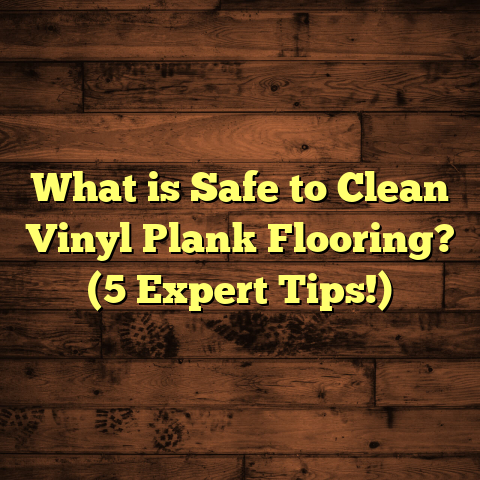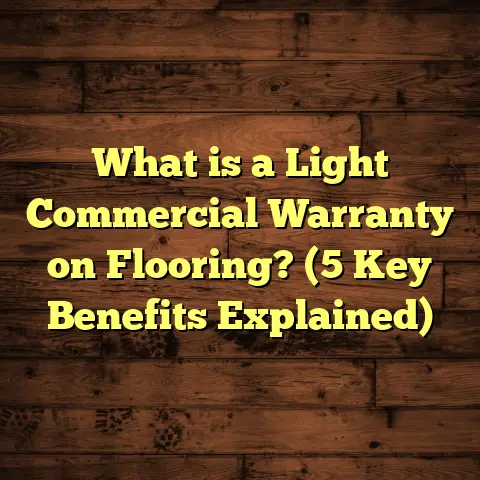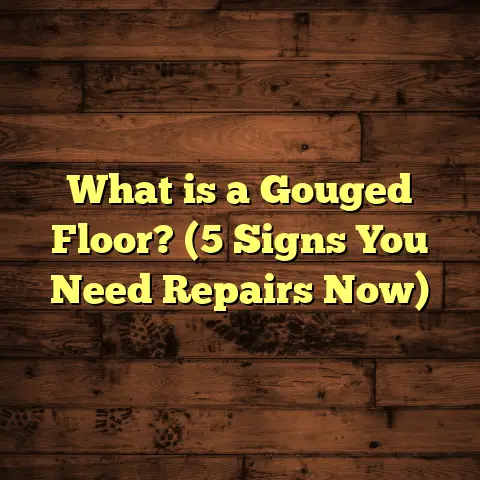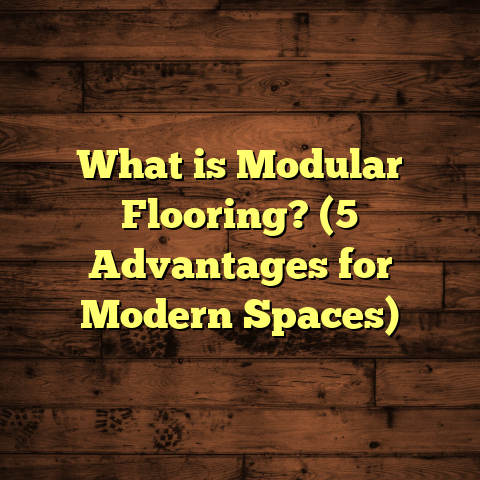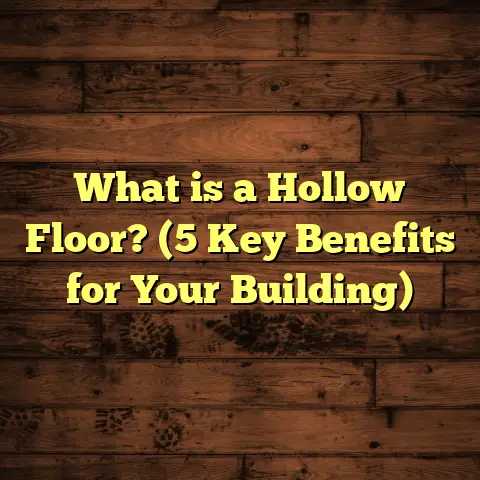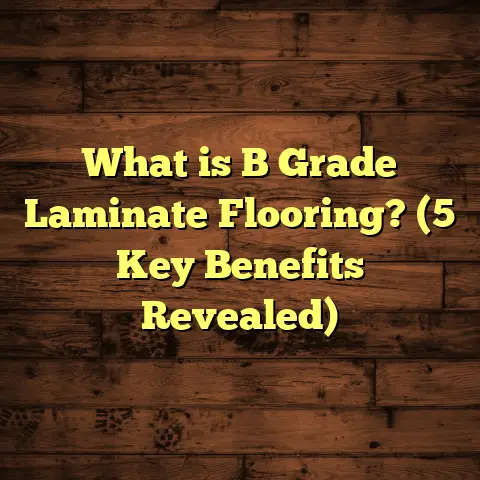What is Fake Hardwood Flooring Called? (5 Types You Should Know)
What is Fake Hardwood Flooring Called?
If you live in the Pacific Northwest or anywhere else with fluctuating weather, you probably understand how tricky it is to maintain hardwood floors. I’ve been in the flooring business for more than a decade now, and I’ve seen how homeowners around here want that warm, classic look of hardwood but struggle with its upkeep. Between rainstorms, muddy boots, and the occasional pet accident, real hardwood just isn’t always the best fit.
That’s where “fake hardwood” comes into play — those flooring options that look like real wood but aren’t quite what they seem. But what exactly is this fake hardwood flooring called? And which types should you know about before making a choice that suits your lifestyle, budget, and home environment?
Over the years, I’ve installed countless flooring types, dealt with customer questions, and studied materials closely. I want to share everything I’ve learned about the five main types of fake hardwood flooring so you can make the best decision for your space.
What is Fake Hardwood Flooring?
“Fake hardwood flooring” refers to any flooring material designed to imitate the look and feel of natural hardwood but made from different components. The goal is to capture the beauty and texture of real wood while offering benefits like durability, moisture resistance, easier installation, or cost savings.
Unlike solid hardwood—which is cut from a single piece of timber—fake hardwood floors are generally manufactured using layers or synthetic materials to replicate wood’s appearance. Each type uses a unique process to achieve this look:
- Some use photographic printing combined with protective layers.
- Others combine thin slices of real wood over engineered cores.
- A few rely entirely on plastic or composite materials with embossed textures.
Depending on your needs—whether it’s a kid-proof floor, moisture resistance for a basement, or an eco-friendly choice—you’ll find that “fake hardwood” isn’t just one thing but several options with different engineering behind them.
The Five Main Types of Fake Hardwood Flooring
Let me break down the five most common kinds of fake hardwood floors I encounter on jobs, along with the technical details, costs, pros and cons, and personal stories from my experience.
1. Laminate Flooring: The Classic Hardwood Lookalike
Laminate is probably the first option people think of when they hear “fake hardwood.” It’s been around since the late 20th century but has improved massively in realism and durability.
What Laminate Is Made Of
Laminate flooring consists of multiple layers pressed together:
- Core Layer: Usually high-density fiberboard (HDF) or medium-density fiberboard (MDF) forms the base. This gives the plank structure but is vulnerable to water if exposed.
- Design Layer: A high-resolution photographic image of wood grain printed on paper. This layer gives laminate its wood-like appearance.
- Wear Layer: A tough, transparent melamine resin coating protects against scratches, stains, and fading.
- Backing Layer: Provides stability and moisture resistance from underneath.
The manufacturing process involves compressing these layers under heat and pressure to bond them tightly. The wear layer’s thickness varies by product grade and affects durability.
Why Laminate Became My Go-To Recommendation
I remember installing laminate in my sister’s dining room in Minnesota where winters are brutal. She wanted hardwood floors but was worried about snow tracked inside causing damage. Laminate offered the wood look without the maintenance hassles. Plus, it was easy enough for us to install as a DIY project over a weekend.
Laminate floors have come a long way aesthetically too. Modern printing technology combined with embossed textures makes them surprisingly realistic—especially when you look at wider planks with natural color variations.
Technical Specs
- Thickness: 6mm – 12mm
- Wear layer: 0.2mm – 0.5mm (higher end means better scratch resistance)
- Installation: Floating tongue-and-groove system (no glue or nails needed)
- Cost: $1 – $5 per sq ft (material only)
- Lifespan: 10 – 30 years depending on quality
Industry data shows laminate remains one of the fastest-growing flooring products in North America. A study by ResearchAndMarkets.com in 2023 projected global laminate flooring markets to grow by 6% annually through 2028 driven by demand for affordable wood-look floors.
My Observations
Laminate isn’t perfect—it swells if exposed to standing water and can sound hollow underfoot if not installed properly over a good underlayment. But for busy families or renters who want style without commitment, it’s a solid choice.
2. Engineered Hardwood: Real Wood Meets Modern Tech
Engineered hardwood blurs the line between fake and real hardwood because it features a thin layer of real wood on top but relies on manufactured layers underneath.
How Engineered Hardwood Is Made
The top veneer is sliced from actual hardwood logs (oak, maple, hickory, etc.) in thicknesses ranging from 0.6mm to 6mm depending on quality.
Below this veneer are multiple plywood or high-density fiberboard layers arranged crosswise (grains perpendicular). This cross-ply construction greatly improves dimensional stability compared to solid wood.
The layers are glued together under heat and pressure for strength.
Why Engineered Hardwood Stood Out for Me
I installed engineered hardwood in a coastal Oregon home where humidity swings were constant. Solid hardwood would have warped or cuped badly over time. The engineered floors resisted moisture better without losing that authentic wood feel.
Plus, engineered hardwood can often be sanded and refinished once or twice depending on veneer thickness—something laminate or vinyl can’t do.
Key Specs
- Top veneer thickness: 0.6mm – 6mm
- Core layers: 3 – 12 layers cross-ply plywood/HDF
- Installation: Nail-down, glue-down, or floating
- Cost: $3 – $10 per sq ft
- Lifespan: 20+ years with care
According to industry reports from the Wood Flooring Manufacturers Association (WFMA), engineered hardwood sales have steadily increased over the past decade as more homeowners want real wood look with modern durability.
Technical Insight
The thickness of veneer determines how many times you can refinish it. Thicker veneers (4mm+) allow more sanding cycles but cost more upfront.
3. Luxury Vinyl Plank (LVP): Waterproof Wood Look for Any Room
Luxury Vinyl Plank has exploded in popularity over the past decade as a water-resistant yet stylish alternative to both laminate and hardwood.
Manufacturing Process
LVP is made from polyvinyl chloride (PVC) layers:
- Backing layer: Rigid PVC or fiberglass for strength
- Printed vinyl layer: High-definition digital print replicates wood grain patterns
- Wear layer: Urethane or aluminum oxide coating for scratch/wear resistance
Some LVP products also contain an attached underlayment for sound absorption.
The printed vinyl layer can include embossed textures that mimic wood knots and grain depth for realism.
Why LVP Was Perfect for My Bathroom Project
I recently helped a friend renovate her bathroom in Seattle where water exposure was constant. She loved the look of wood floors but couldn’t risk warping or mold issues with hardwood or laminate.
LVP turned out to be waterproof and easy to clean while giving that warm wood look she wanted.
Specifications
- Thickness: 4mm – 8mm
- Wear layer: At least 12 mil (0.3mm) recommended for residential use
- Installation: Floating click system or glue-down
- Cost: $2 – $7 per sq ft
- Lifespan: 15 – 25 years
Industry Data
Floor Covering Weekly reported LVP sales increasing by more than 25% annually recently as homeowners seek waterproof, pet-friendly floors that don’t sacrifice style.
My Takeaway
While LVP doesn’t have real wood on top like engineered hardwood, its water resistance and durability make it ideal for kitchens, bathrooms, basements, or even commercial spaces where spills happen.
4. Wood-Look Ceramic & Porcelain Tile: Durable & Stylish
This is a category that surprises many people—ceramic or porcelain tile designed to look like wood planks.
How They’re Made
Manufacturers use advanced digital printing technology to create highly detailed wood grain patterns on tile surfaces.
The tiles undergo high-temperature firing (over 1200°C) which vitrifies the material making it extremely durable and water-resistant.
Surface textures are embossed to mimic natural wood grain feel while providing slip resistance.
Where I Recommend Wood-Look Tile
In hot climates like Arizona where heat and moisture are concerns, I often suggest wood-look porcelain tile in kitchens or outdoor patios. A client in Phoenix loved how she got her favorite rustic oak look without worrying about heat warping floors or water damage outdoors.
Technical Specs
- Tile size: Commonly planks such as 6”x24”, 8”x36”
- Water absorption: Less than 0.5% for porcelain tile
- Cost: $3 – $10 per sq ft
- Lifespan: 30+ years
Tiles are heavier than other fake hardwood options and require professional installation including mortar and grout work.
Durability
Porcelain tile is scratch-resistant, heat-resistant, and waterproof—making it great for high-moisture areas.
5. Composite & PVC-Based Wood-Look Floors
These are less commonly known but growing fast—composite floors blend recycled wood fibers with plastic resins, creating boards that look like wood but resist dents and moisture better than traditional laminate.
Other options are fully synthetic PVC planks embossed with wood grain patterns.
Manufacturing Details
Composite boards combine cellulose fibers from recycled wood waste mixed with thermoplastics like polyethylene or PVC under heat/pressure.
PVC-based planks use extrusion processes with detailed embossing rollers to create realistic textures.
My Experience with Composite Floors
I installed composite flooring in a commercial office lobby expecting heavy foot traffic plus occasional spills. The floor held up better than laminate would have—no swelling, no dents—and looked great after years of wear.
Specs
- Composition: Usually 50-70% recycled fibers + plastic resins
- Thickness: Similar to laminate or engineered
- Cost: $2 – $6 per sq ft
- Lifespan: 15 – 20 years
These products appeal especially to eco-conscious buyers or those needing extra durability without sacrificing style.
How I Estimate Flooring Costs Using FloorTally
Accurately pricing flooring projects is something I’ve had to learn through trial and error. Between material costs fluctuating regionally, labor rates varying by town, and waste factors adding complexity—it can be tough to get quotes right on the first try.
Over time I started using FloorTally—a tool that helps me plug in location-specific data like local labor fees and material prices while factoring in waste percentages (usually around 5%-10% depending on installation).
This lets me generate detailed cost estimates quickly without juggling multiple spreadsheets or chasing subcontractors for pricing info.
FloorTally also lets me compare different materials side-by-side on price versus durability so I can recommend what fits my client’s budget best without surprises later on.
Honestly, it’s saved me hours on projects from small Minneapolis condos to large Dallas houses by streamlining budgeting and helping clients visualize costs clearly upfront.
More Thoughts From My Years Working With Fake Hardwood Floors
How Climate Impacts Your Choice
Living in places like Florida with humidity swings? Go engineered hardwood or vinyl-based products over solid wood to minimize warping risks.
In drier areas like Colorado? Laminate can work well as long as you manage dust buildup which can scratch surfaces over time.
Installation Tips From My Toolbox
I always stress good subfloor prep regardless of material—levelness matters for preventing gaps or squeaks later.
For floating floors like laminate or LVP, using quality underlayment improves sound insulation and comfort underfoot.
Leave proper expansion gaps around room edges since fake hardwood materials expand slightly with temperature changes.
Maintenance Insights
Fake hardwood floors typically require less maintenance than solid wood:
- Sweep regularly
- Use damp mop only (never saturate)
- Avoid harsh chemicals that can degrade wear layers
Some laminates can’t be refinished if scratched deeply. Engineered hardwood offers some refinishing options depending on veneer thickness.
Real Stories From Homeowners Who Chose Fake Hardwood
One client I worked with in Seattle loved her luxury vinyl plank floors so much she called me months later just to say how easy cleanup was after her toddler learned to walk—no stress about spills or scratches!
Another in Boston chose engineered hardwood after seeing their neighbors’ solid wood floors cup badly during winter months due to moisture fluctuations—and loves the natural warmth coupled with stability.
A couple in Texas went with wood-look porcelain tiles outdoors so their patio matched their interior floors perfectly while standing up to sun and rain without fading or cracking.
Final Thoughts
Fake hardwood flooring covers a wide range of products—from laminated surfaces printed with high-res photos to genuine wood veneers over plywood cores—and each brings unique benefits depending on your home’s environment and your lifestyle needs.
Whether you’re working around pets and kids like I have often seen firsthand, battling moisture challenges, or budgeting carefully while wanting style—the options I’ve shared give you plenty of tools to pick flooring that fits your life beautifully without breaking your budget.
Got questions about which type might suit your house? Or need tips on installation? Just ask—I’m happy to share what I’ve learned over thousands of square feet laid down across all kinds of homes and climates!
